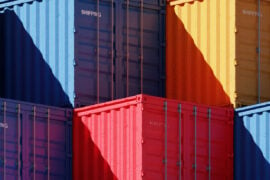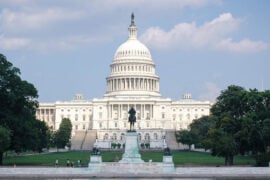In brief
On 25 September 2020, the Parliament adopted the “Federal Act on the Adaptation of Federal Law to Developments in the Technology of Distributed Electronic Registers.” With this law, various federal laws are selectively adapted, enabling Switzerland to continue to distinguish itself as a leading, innovative and sustainable location for projects in the field of blockchain or distributed ledger technology (DLT). The associated ordinance is currently in the consultation phase until 2 February 2021.
Federal Council puts the first part of the DLT/Blockchain legislative package into force
On 25 September 2020, the Parliament adopted the “Federal Act on the Adaptation of Federal Law to Developments in the Technology of Distributed Electronic Registers.” With this law, various federal laws are selectively adapted, enabling Switzerland to continue to distinguish itself as a leading, innovative and sustainable location for projects in the field of blockchain or distributed ledger technology (DLT). The associated ordinance is currently in the consultation phase until 2 February 2021.
The key adaptations are being made at the legislative level in the Code of Obligations (CO), the Debt Collection and Bankruptcy Act (DCBA) and the Financial Market Infrastructure Act (FMIA). The private law adaptations, including a new registered uncertificated security, will be put into force by the Federal Council as early as 1 February 2021. The remaining adaptations to laws and regulations are expected to come into force on 1 August 2021.
The present report focuses in particular on the new “registered uncertificated security” (Art. 973d et seqq. CO) and the new licence category “DLT Trading Facility” (Art. 73a et seqq. FMIA) and shows the opportunities and requirements of these new rules.
Trading on the blockchain with registered uncertificated securities
The real asset token does not legally exist today
Despite the repeated promises in ambitious white papers, it has not been legally possible to link rights, such as ownership of gold bars, shares or claims, directly to a token. The reason for this lies in the fact that the transfer of a right always (also) requires a written assignment (cf. in particular Art. 164 and 973c para. 4 CO). The written assignment on its part requires signatures of the parties to the contract appended by hand on a piece of paper (Art. 14 para. 1 CO). Indeed, the authenticated electronic signature within the meaning of Art. 14 para. 2bis CO is deemed equivalent to a handwritten signature. However, the authenticated electronic signature has never been an acceptable option for the DLT industry due to the sparse certification bodies and the accreditation effort required. In other words, based on the current law, the transfer of a token cannot, by law, result in the transfer of the right allegedly documented by it. This fact will be corrected on 1 February 2021.
Registered uncertificated security as a solution
Under current law, rights or securities entrusted to a single custodian may be replaced by uncertificated securities (Art. 973c para. 1 CO). An uncertificated security is a paperless security and can “document” everything what a security can document, such as the ownership right to goods, gold or shares and claims.
An uncertificated security arises with and exists in accordance with the entry in the uncertificated security book (Art. 973c para. 3 CO) that is kept by the debtor. This uncertificated securities book must contain the number, denomination and creditors of the uncertificated securities (Art. 973c para. 2 CO). However, the transfer and thus also the assertion of an uncertificated security takes place off the books. The transfer requires a written assignment and the assertion requires evidence of the seamless (written) assignment chain (Art. 973c para. 4 CO).
With the amendment to the law, the Parliament is now introducing the registered uncertificated security. A registered uncertificated security is first of all an uncertificated security like the one just described. It must therefore also be entered in an uncertificated securities book, i.e., an uncertificated securities register. However, it has a decisive peculiarity compared to the simple uncertificated security: The registered uncertificated security can neither be transferred nor asserted off the register by express agreement of the parties involved. In other words, a registered uncertificated security can only be transferred and asserted via the uncertificated securities register (Art. 973d para. 1 nCO).
Requirements for the uncertificated securities register
An uncertificated securities register must meet certain legal requirements in order to be considered as such. The draft law does not mention the terms “blockchain” or “DLT.” However, the legislator had the DLT systems in mind when formulating the requirements for the uncertificated securities register.
In order for a DLT system to be recognised as an uncertificated securities register, it must meet at least the following four legal requirements (Art. 973d para. 2 nCO):
- Power of disposal: The holder of the registered uncertificated security (token holder) must have the power of disposal over the register entries or his tokens. This power of disposal must not only be promised by contract but also technically guaranteed.
- Integrity: The integrity of the uncertificated securities register must be protected against unauthorised changes by appropriate technical and organisational measures. The draft law mentions as an example the joint administration of the uncertificated securities register by several independent parties. The example is tailored to DLT systems.
- Transparency: The registered uncertificated security is preceded by an agreement between the parties that the registered uncertificated security can only be transferred and asserted via the uncertificated securities register. The content of the right “documented” by the registered uncertificated security as well as its functionality must be clearly formulated and made available to everyone involved either in the DLT system itself or via a link that can be accessed through the DLT system.
- Independent access: The token holder must always be able to view and check the information and register entries relating to them without the intervention of a third party.
The documentation of shares as registered uncertificated security as an application example
The introduction of the registered uncertificated security allows shares to be structured in the form of tokens. The uncertificated securities register can, like the uncertificated securities book, function as a share register. In a DLT system, the management of the share register is thus externalised or transferred to those involved in the uncertificated securities register. The prerequisite is, of course, that the board of directors can inspect the entries in the uncertificated securities register at any time.
A DLT system can be equipped with additional functions that enable shareholders’ rights and obligations under company law to be processed via the DLT system. In particular, the following application examples can be listed:
- Reporting requirements: Shareholders must notify the company of their identity and address (Art. 686 CO). When the applicable thresholds are reached, shareholders must also disclose the beneficial owner of shares (cf. Art. 697j CO). These reporting obligations can be fulfilled digitally via corresponding functions in the DLT system. Furthermore, it is possible to make the transferability of shares conditional upon the fulfilment of the reporting obligations.
- Voting: At present, and probably also on 1 February 2021, voting in writing is prohibited under company law. However, the new company law adopted by the Parliament on 19 June 2020 allows voting in writing on paper or in electronic form in Article 701 (3) nCO. This means that a corresponding function in the DLT system can be used to enable resolutions to be passed directly via the DLT system.
- Dividends: Similarly, dividends from a company limited by shares can be paid out directly to shareholders via the DLT system in the form of a crypto currency such as Bitcoins.
In summary, the new law enables digital management of shareholder rights and obligations of a company limited by shares.
The DLT Trading Facility as new trading facility
Existing regulatory environment for trading facilities
In its current version, the FMIA recognises three types of trading facilities for financial instruments: the stock exchange, the multilateral trading facility (MTF) and the organised trading facility (OTF).
Stock exchanges and MTFs are referred to as “trading venues” and are facilities for multilateral trading of securities. Trading is based on the simultaneous exchange of offers among several participants with the conclusion of a contract according to non-discretionary rules, i.e., without discretionary decisions by the operator of the trading venue. The difference between these trading venues is that listed securities are traded on a stock exchange, and securities without listing are traded on a multilateral trading facility. The operation of these financial market infrastructures requires a specific exchange or MTF licence.
In contrast, OTFs are not considered independent financial market infrastructures and therefore do not require approval of the Swiss Financial Market Supervisory Authority FINMA. However, FINMA supervises OTFs indirectly through their operators, which may be exclusively licensed financial institutions (banks, securities dealers or trading venues, i.e.stock exchanges or MTFs).
| Stock Exchange | MTF | OTF | |
| Authorisation | Authorisation required | Indirectly – Only banks, stock exchanges, MTFs or securities dealers may operate an OTF. | |
| Type of trade | Multilateral | Multilateral and bilateral | |
| Object of trade | Listed securities | Securities (without listing) | Securities and other financial instruments |
| Trade rules | Non-discretionary | Non-discretionary or discretionary | |
| Participants | Exclusively securities dealers and certain other categories of supervised financial institutions | No restrictions | |
The above overview shows that although securities (tokens) can be traded on a stock exchange or MTF, these trading venues are not open to the public. Only securities dealers and other supervised financial institutions can be trading participants of stock exchanges and MTFs. Consequently, retail investors participate in trading only indirectly, via their financial intermediary. Likewise, OTFs, which allow the direct participation of individuals and unregulated legal entities, may only be operated by authorised financial institutions (stock exchange, MTF, bank or securities dealer).
This “obligation to mediate” contradicts the basic concept of the DLT. It is not possible to trade crypto-based securities at a trading venue as an unregulated financial institution or private individual, and only authorised financial institutions may operate a trading facility with access for non-supervised entities.
Introduction of an independent DLT financial infrastructure
The creation of a new license category for the financial market infrastructure type “DLT Trading Facility ” is intended to provide an appropriate and flexible legal framework for DLT. This will remove existing obstacles to the use of DLT and create further potential for innovation.
DLT Trading Facilities are designed as financial market infrastructures that provide trading services for DLT securities on a commercial basis. DLT securities also include the newly introduced registered uncertificated securities and their foreign counterparts. Similar to the existing trading venues, DLT Trading Facilities can enable multilateral trading, i.e., the simultaneous exchange of offers and several participants as well as the conclusion of contracts according to non-discretionary rules. As a uniform financial market infrastructure, the DLT Trading Facility can offer post-trading services with DLT securities in addition to trading, without the need for additional approval from FINMA. These permissible post-trading services include, for example, central custody or settlement and clearing of DLT securities and thus services that are currently reserved for specially authorised central securities depositories and payment systems. In addition, DLT Trading Facilities may also act as a custodian within the meaning of the Book-Entry Securities Act and thus create book-entry securities.
As a central point, the new legislation provides for an important innovation with regard to participants: In addition to financial institutions, individuals and unsupervised legal entities are also permitted to participate in DLT Trading Facilities, provided they declare that they are participating in their own name and for their own account. This opens up many new business opportunities and also enables retail customers to participate directly in an organised trade in crypto-based assets.
Requirements for DLT Trading Facilities
In principle, the usual requirements for financial market infrastructures associated with licensing and prudential supervision also apply to DLT Trading Facilities. These are in particular the organisational and guarantee requirements as well as capitalisation requirements that vary according to the category of authorisation. In addition, there are special requirements imposed on trading venues. These include, in particular, rules on the organisation of trading, transparency requirements and requirements to ensure orderly trading. As with the other trading facility categories, these are regulated in principle in the FMIA but are largely substantiated in the operator’s self-regulation.
DLT Trading Facilities providing custody, settlement or clearing services must also comply with additional requirements, including those relating to the safekeeping, booking and transfer of securities, as well as criteria relating to collateral, own funds, liquidity, procedures in the event of participant default, and asset segregation.
In particular, with regard to the minimum capital requirements, the different risks inherent in the various business activities are taken into account. Depending on whether a DLT Trading Facility provides custody, settlement and/or clearing services, the minimum capital requirements vary from CHF 1 million if no such services are provided, to CHF 5 million if such services are provided. To meet market needs, small DLT Trading Facilities may benefit from exemption regulations.
Tradable digital assets and prospectus requirement
In principle, the operation of a trading facility for pure crypto currencies (payment tokens), such as Bitcoin, does not require a licence under Swiss law. Similarly, utility tokens can be freely traded on facilities, at least if they are not of an investment nature. Accordingly, trading facilities for digital assets may already be operated under the current law. However, until the introduction of the DLT Trading Facility in the FMIA, the operation of a trading facility for the trading and settlement of asset tokens that are suitable for mass trading (and thus embody securities) remains prohibited. The innovation of the DLT Trading Facility is accordingly the systemic trading of crypto-based assets that are designed as securities.
A DLT Trading Facility, on the other hand, does not have to be limited to securities. The operator of the system may provide in its self-regulation that other financial instruments (e.g., non-fungible asset tokens) or other types of tokens (e.g., pure crypto currencies) may also be admitted to trading.
The prospectus requirement for tokenised financial instruments corresponds in principle to the general rule: Anyone who makes a public offer to purchase securities in Switzerland or who requests the admission of securities to trading on a trading venue pursuant to the FMIA must first publish a prospectus. Although DLT Trading Facilities are not “trading venues” under the FMIA, Parliament has inserted a special standard for DLT financial instruments into the Financial Services Act (FinSA): “For the admission of DLT securities … to trading on a DLT Trading Facility … Articles 35-57 and 64-69 apply mutatis mutandis.”
It is thus clear that both the substantive rules (content) and the formal rules (preliminary examination and publication) apply to prospectuses under the FinSA. The provisions on the key information document (KID, Art. 58-63 FinSA) are excluded from the analogous application ̶ this is, however, explained by the fact that the obligation to produce a KID is only linked to the offer and not to the trading license. If a DLT security is offered to private customers in Switzerland, a KID must always be prepared. However, no KID is required for securities in the form of shares, including equity securities equivalent to shares such as participation or dividend-right certificates, as well as debt securities without derivative character.
What is less clear at this stage is what the “mutatis mutandis” application of the prospectus rules entails. The Federal Council will probably be allowed to determine certain simplifications and tightening measures at the ordinance level that are tailored to the DLT. Of course, the Federal Council has not (yet) made use of this regulatory competence in the consultation draft of the DLT Shell Ordinance of October 2020.
Conclusion
With the introduction of the new law, real asset tokens can be created and now also traded via DLT Trading Facilities. The new right does not relieve the existing regulations, but rather opens up the possibility of using DLT for the relocation of and trading in assets via a new technological means. Together with the new company law, it will be possible to process rights and obligations under company law digitally using a simple app.
DLT Trading Facilities differ from conventional regulated securities trading facilities in that they allow: (i) individuals and non-regulated legal entities to participate in trading; (ii) the safekeeping of DLT securities; and (iii) the settlement and clearing of transactions in DLT securities. DLT Trading Facilities may also differ from existing token trading venues in that they: (i) allow trading in asset tokens (securities); (ii) allow custody of crypto-based assets; and (iii) create book-entry securities.
The new trading facilities category thus opens the door for supervised DLT Trading Facilities. The new licence will allow unlicensed persons to participate in trading, piercing the principle of investor protection, but in line with the DLT concept. Whether the new trading category will indeed enjoy great popularity and whether gaps in investor protection will become apparent remains to be seen in the near future.
However, it is not necessary to use a licensed DLT trading system to transfer tokens. If the tokens are not structured as securities or if no systematic multilateral trading is to take place, the new registered uncertificated security will also allow tokens to be transferred directly on the blockchain without the need for a settlement system. A key feature is that, in contrast to the current law, the registered uncertificated security will allow a direct transfer without the requirement of a written form.



